It's the uneasy space between cultivation and chaos that enables the most transcendental consideration of human culture in the cosmos.
By Mark Fenton
Published July 21, 2017
These trees he made more directly helpful, thus being at the same time a friend to his neighbour, to nature and to himself... Then, with the advent of more careless generations, of improvident greed, of people who loved nothing, not even themselves, all was to change, and no Cosimo will ever walk the trees again.
—Italo Calvino
Two trees of a similar height. Spindly trunks. A clump of green at the top. Against a foreboding sky.
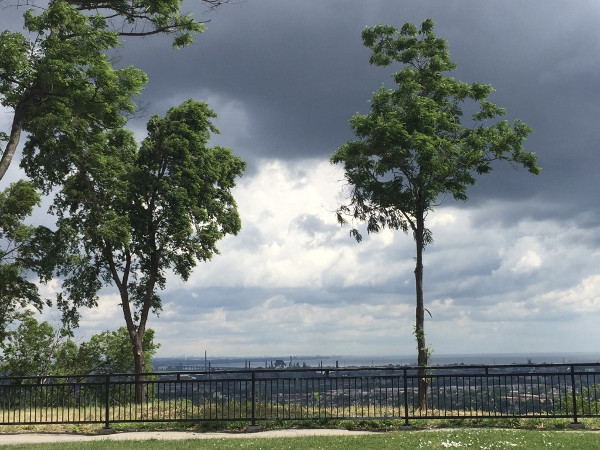
They suggest a gateway and have immediate, if accidental, roots in Meindert Hobbema's 1689 "Avenue at Middelharnis."
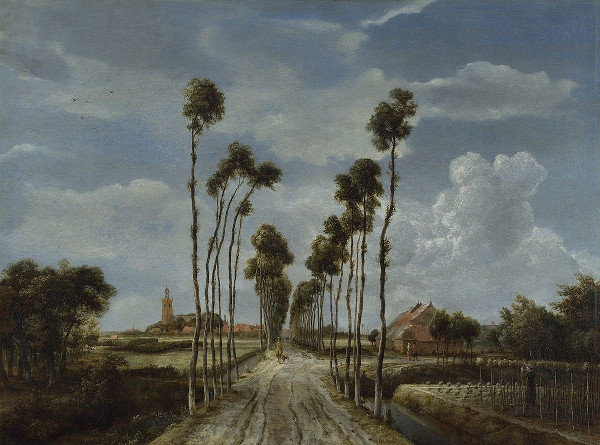
The colour of the sky and blur of saturated greens from a spring of heavy rains makes a connection I might well have missed in a different hour of a different day.
I've long lamented that I can't walk along Hobbema's avenue, but neither can I walk into the live, June 20th 2017 "Hamilton Landscape from Mountain Brow," so I settle for standing at the rail and trying to estimate the vanishing point of the parallel streets, which I put in Toronto, at about Dufferin and Bloor.
Correct me if you're a pilot and can sift through past flight plans and determine the point more accurately.
I'm already half way into today's tour. The trip up from Kenilworth is pretty complex for the uninitiated, with its unexpected switchbacks, signage of a mindboggling wordcount that broadcasts rapid temporal and spatial variables to the motorist that the motorist must digest at jittery speeds through curves and angles that this motorist equates with the Behemoth
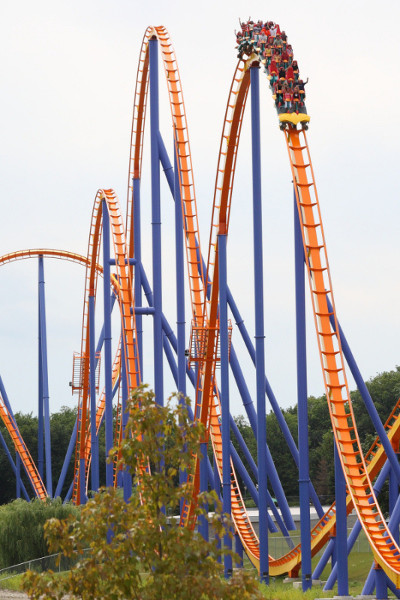
at Canada's Wonderland (reproduced in lieu of the aforementioned signs which for obvious safety reasons I didn't photograph), signs that pronounce certain options in certain directions at certain hours strictly forbidden, and there's also a traffic circle on the way up just to thicken the plot and which confused me to such a degree that on my first attempt I pulled eject 180 degrees off the correct exit for my destination,

and if you think you're stressed getting through this sentence, imagine how I felt driving it.
The Mona Lisa is usually thought of as a portrait, but I've always seen the figure as little more than excuse/divider for two compelling surrealist landscapes
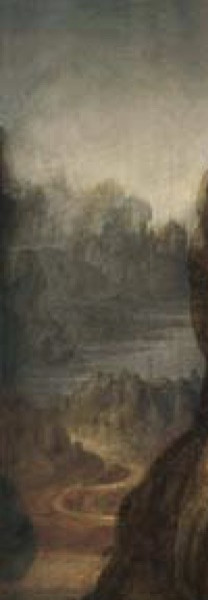
and
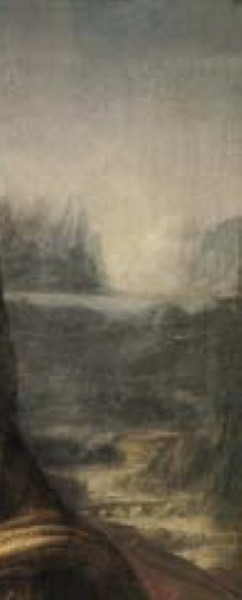
and yes, it has occurred to me that a therapist of a certain school might say this response explains my preference for solitary walks over, say, accumulating friends on Facebook.
Consult the full painting - easily available on the internet - at your convenience and note that there's no possible way the lines of the two landscapes can, with any geographic logic, be made to meld, in the unlikely event that Mona, sedentary for half a millennium, were to impulsively get up and make bruschetta or go for a jog or something.
I'll go out on a limb and guess that Leo was so late with the rent he got evicted, that he and Mona wandered studioless with easel and paints (and likely a fair bit of bickering) knocking on doors of friends whose benevolence they'd already stretched to the limit during previous lean times, and found sanctuary at the 11th hour in the attic of Mona's creepy uncle Paolo, whose window had a different view and really we all just have to work with what we've got at any given time and I think you can feel the exhaustion of their housing crisis in the slack fuzzy painting of the disconnected landscapes.
While I'm able to see past that and enjoy the picture's personal authenticity, others may recoil at the slapdash backdrop and regard Mona Lisa as the most skipable painting in the Louvre. De gustibus non est disputandum.
Why all this occurs to me right now is because I've just looked down from the broad vista of Mountain Brow Boulevard, onto the strange joining roads that don't look like they could ever connect or even be part of the same landscape, but which they must do,

because they're how I got up here.
Driving them I was struck by the startling geometric cracks on the face of the escarpment
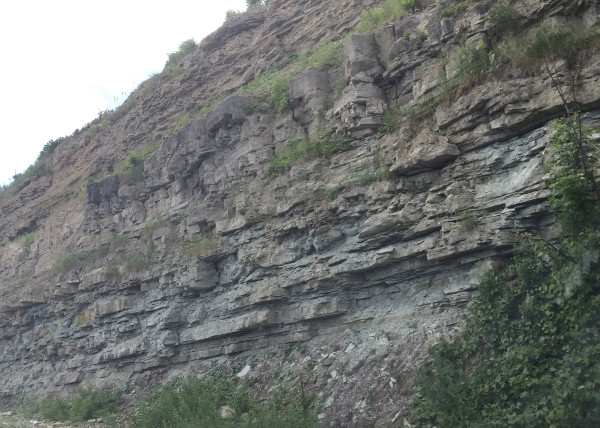
and what a compellingly structured mess they are, a set of fissures that give the face meaning for me, as they morph into the cracks that mar the literal face of the Mona Lisa, whose surface would be less compelling for me if it weren't marred by the scars of time.
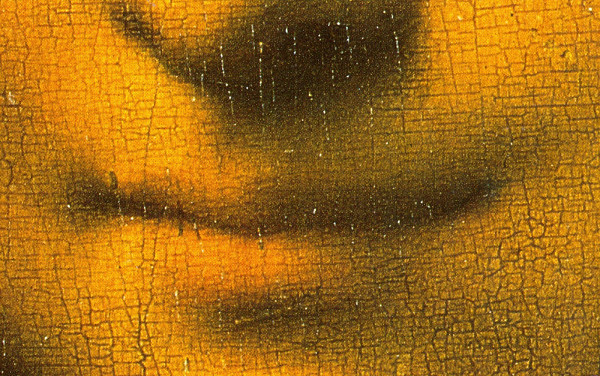
I flee human company to anthropomorphize landscape. So sue me.
One imagines an out-of-towner seeing this
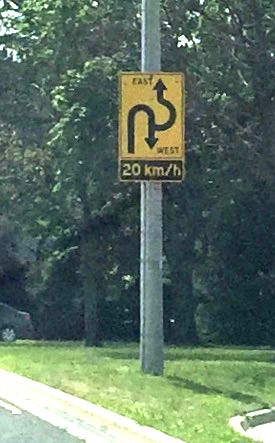
and saying to herself "oh, another one of those - I should be able to navigate them in my sleep by now." Clearly the structure is so common there's a generic sign for it, though its cuddled teardrops (one for each eye?) are like nothing else I've encountered.
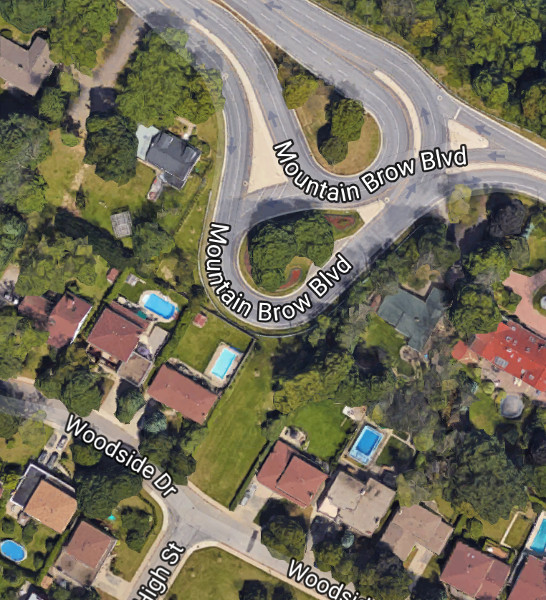
I've only ever driven them for the mystery of the curves, never to get anywhere I needed to be and I have no sense of their geometry.
Examining an aerial view of them on Google Maps while sitting in my car, the similarity to paisley is unmistakable.
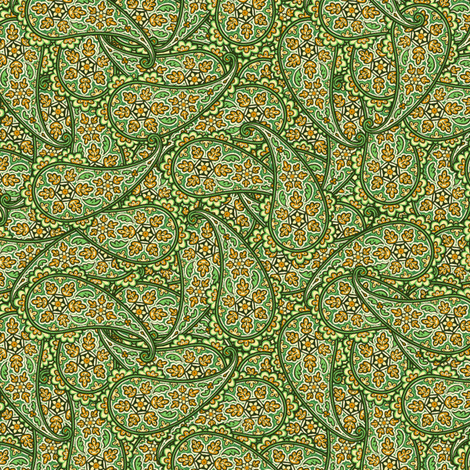
I cue up The Psychedelic Sounds of the 13th Floor Elevators
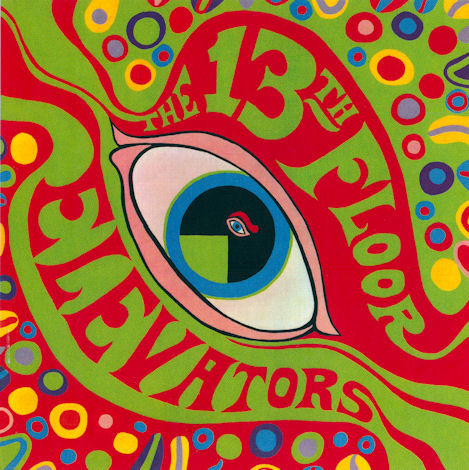
on my iPhone and embark on my trip.
As I child growing up in the sensory deprivation tank of Regina at the time TPSOT13thFE was released - basement apartment of a three-floor walk-up, black and white television with two channels of nothing, brown patterned carpet whose geometric relationships I studied for so many hours I could have written a math thesis on them by the age of three, you get the idea - an object that gave my imagination endless fuel was the globe next to my bed.
I would rotate it for hours and invent scenarios for faraway places whose cultures I knew absolutely nothing of. Perhaps the patch of globe that most haunted me was the small diamond of territory (the only territory in stark white on the entire sphere) between Saudi and Iraq, designated as Neutral Zone. (I'll go out on a limb and guess it wasn't a great geography for developing condos.)
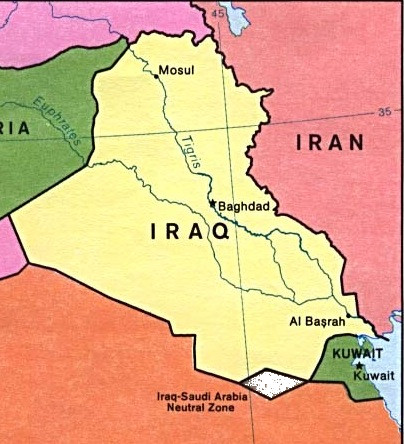
According to Wikipedia (who have it not in white but in brown, as though rather than void it's a place charred by millennia of unrelenting desert sun, or an irredeemable atrocity), it existed as such from 1922 to 1975, at which time a formal border was finally drawn.
To me at the age of about five it was the most fascinating place on the planet. A place unaccounted for. Where all and any things might be: magic carpets whose designs contained encrypted secrets, towers whose gangly stasis violated all known laws of physics, myriad large objects that could be of no use to people yet which were unquestionably made by people.
Such possibilities occupied my thoughts while falling asleep. (Should adult reality be the finale of childhood fantasy? Do I want to go there now in flesh and blood and observe what's really there? Nope.)
The word 'Zone' in anything conjures up absolutes of the most conceptual speculative fiction. So the flip side of these fantasies was that the Neutral Zone contained Nothing. Capital N nothing. Heideggerean why-is-there-something-rather-than-nothing Nothing.
These were the kind of ruminations that the years prior to kindergarten are so good at planting in the mind of the child on the bald prairie forced nightly to bed at 20:00. For one already leaning to the secular, the Neutral Zone also summoned the unimaginable possibility of absolute void and its attendant assault on identity: Non-existence, non-consciousness, nothing. Anywhere. Ever. Any more.
This kept me awake.
Since then ideas of unaccounted urban space have both fascinated and frightened me. And it was beside just such a space that I parked. If you consult the aerial photo above, it can be seen just south of the twin fœti with which Mountain Brow Boulevard has been impregnated.
It's a great space. My favourite kind of space. A space in the thick of the city that hasn't been accounted for. It could contain a house but it doesn't. It could be a park, but it isn't. It could be paved, and form a passage from Mountain View Boulevard to Woodside Drive, but hasn't been. It could be a useful pedestrian/cyclist route to the Boulevard, but that it emphatically is not. That would be about as safe as trying to skydive onto the teardrop islands.
The only guidance through it is a small metal sign which can be read as an advisory, a warning or a threat, depending on where your particular nervous system files such texts. It confirms a belief I've long held, that neutral territory breeds fear and suspicion and paradoxically becomes more heavily monitored than the territory employed for quotidian human activities like sleeping in a bed or eating Cheesies.
There are no signs along this block on any of the front yards to forbid me trespassing private property or even telling me to keep off of grass. (Do those signs still exist or did they disappear with the 20th century, along with pesticides that when inhaled by the pregnant might render progeny as amorphous as the twins of Mountain Brow Boulevard? Just asking.) But here at the southwest corner of this untamed, unused, useless greenspace, is a directive that prohibits my loitering.
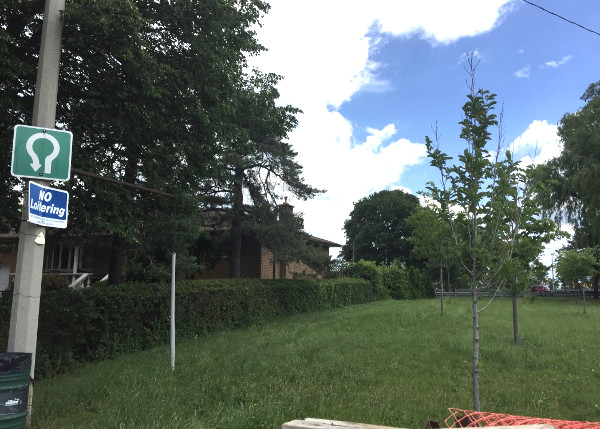
Loitering. One of the great, indefinable legal terms routinely encountered in urban signage. Dictionaries trace the world back medieval Dutch "Lotoren" meaning "wag around" which isn't a whole lot more concrete, though it compellingly draws a comparison between people like me and unleashed dogs. And lurking in the dustier back-basement file-boxes of my subconscious is a scenario - albeit an ontologically challenged one - in which I'm adrift in endless non-being but for a sign that floats through a murk of nothing and which reads, in stark white-on-black sans-serifs:
Most dictionary entries of 'Loiter' approximate "moving in a slow, idle manner, making purposeless stops in the course of a trip or journey."
Heaven help me, but that's a pretty good description of how I live and always have and always want to! So from the outset I'm not asked but ordered to stop being the person I am. Always the reluctant rule-breaker and the luctant compromiser, I enter but resolve to move at a slow steady pace.
Think back to the physician who pressed a cold metal disk to your chest and asked that you cough, and what a supreme act of will that required, and how forced and artificial the cough sounded when you finally produced one. Now recall the time you were seated at a classical piano recital with nothing expected of you but to abide in a non-coughing state, and how, knowing that, it became impossible not to cough, even though you were in the pink of respiratory health and it had been so long since you coughed you couldn't remember when that was.
Sentenced to community service in this greenspace that metastasizes from the bulge of Mountain Brow Boulevard, I'd run the second they blew the whistle at 17:00. But on this perfect day in late spring, the only thing I crave under heaven is the freedom to loiter here.
And the place is thrilling. It's the very DNA of Hamilton. That indeterminate state between cultivation and entropy.
Grass is ankle high to knee high, depending on location relative to larger flora. The edge of the territory up by the fence has weeds growing willy nilly into shrubs and small trees. And yet there are also trees that have been planted,
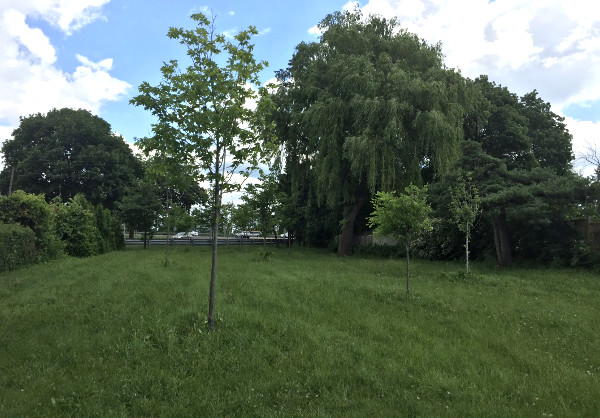
in a manner apparently random and yet which couldn't have happened by natural seeding. Their straightness indicates they were staked.
They remind me of the rocks in the Ryōan-ji garden.
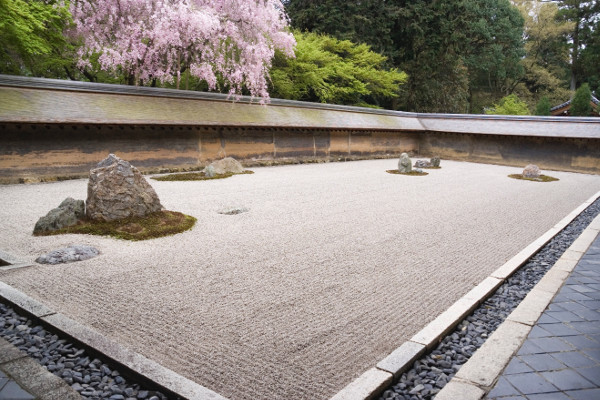
There is enough cultivation around the rocks to convince us their position is of human conception, and yet their placement has no obvious relation to mathematical systems or conventional patterns (unlike the landworks I'll have my very patient readers trudging to in a minute.)
And I would argue that it's the uneasy space between cultivation and chaos that enables the most transcendental consideration of human culture in the cosmos. Environment that invites pattern recognition but never allows a definitive reading, urging us to ruminate endlessly.
You'll find a grueling example of this phenomenon in the Henry James story entitled "The Figure in the Carpet" in which the narrator (a literary reviewer) is determined to find hidden meaning in a work of fiction, one that a few peers claim to have discovered but which they won't share with the narrator. As it's described in the story.
"It was something, I guessed, in the primal plan, something like a complex figure in a Persian carpet."
So. I moved through the zone with a bare minimum of loitering. (I've been debating whether to call this space 'The Zone' or 'No Loitering' and I'm still on the fence. If I'm leaning slightly to 'The Zone' it's only to avoid the semiotic confusion of signifier and signified were I to go with 'No Loitering.')
The other side of The Zone really is intimidating. The lurch from the representations on my iPhone to the things themselves unrolls before me now like carpets whose pattern demands interpretation. From across the Boulevard the teardrops feel inaccessible.
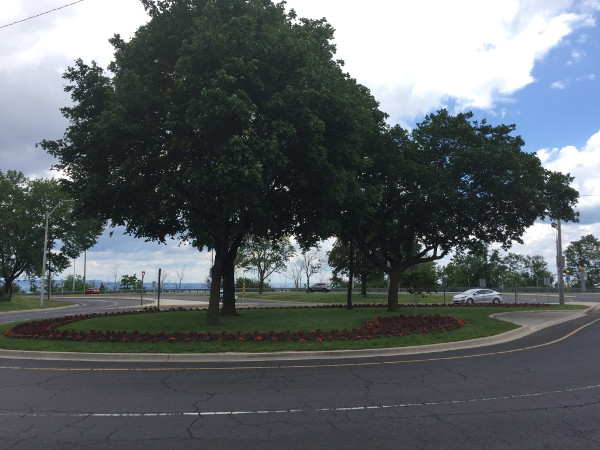
In the teardrop nearest me I notice four trees planted roughly in a square, and I imagine myself becoming the fifth and central point within that square to form a quincunx. (Here, I'll draw what I mean.)
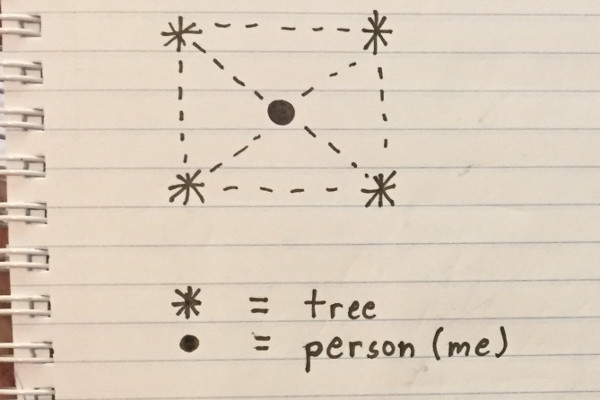
I feel that being central would produce some revelation because surely this is neutral territory, and thus territory in which anything is possible. It should be noted that on this stretch of Mountain Brow Boulevard there are no sidewalks, and no crosswalks, and that once inside the teardrop I could be given a retrospective J-Walking ticket, since the officer would know that short of a parachute drop there is no way I could have gotten there without J-Walking, and where exactly could I be hiding the deployed chute? I was surprised the cruiser that passed didn't pull into the place expressly designed for police to deal with loiterers like me. (See area lower right, two photos back.)
This is where my revelation happens. Not in the quincunx but at the edge of The Zone looking towards the nearest teardrop. One is not master of one's revelations and here mine is:
What exactly are the teardrops doing here?
If The Zone were dynamited and turned into road connecting Mountain Brow Boulevard to Woodside Drive and providing a shortcut for residents, I'd get it. It would be the T-Intersection equivalent to a traffic circle, a way of controlling traffic flow that didn't involve the stop-and-start of traffic lights or all-way stops.
Nor has the road been gerrymandered to accommodate an unbulldozeable geographic formation. In fact given the amount of extraneous paving necessitated by the circuitous routing, the environmental toll feels larger than an uninterrupted two lane road would be. This leaves me with two theories:
1) the structure was imaginatively conceived by municipal councilors and generously funded by municipal coffers as a free, quotidian theme-park ride for East-Hamilton Mountain motorists, the sweet spot, for those who find the Behemoth at Canada's Wonderland straight-up horrorshow batshit; or
2) it's a purely aesthetic, highly conceptual construct, a landwork in the manner of Robert Smithson's Spiral Jetty,
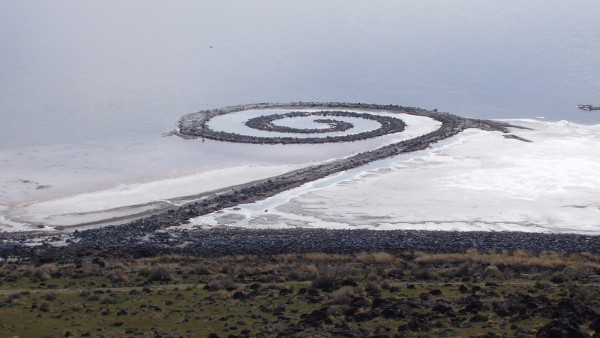
or Michael Heizer's City
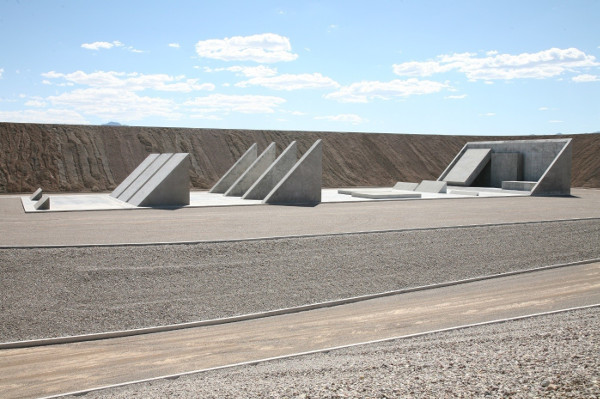
as ineluctable as those works are inaccessible.
I'm onto the first teardrop now. As I admire the flowerbeds which underline the Euler curve of its limit, I start to feel like a louse creeping up the surface of a

paisley tie, eager to be past collar and neck and to attach myself firmly at the base of a hair within in a dense nest of other hairs.
Here I am in the exact middle of the teardrop,
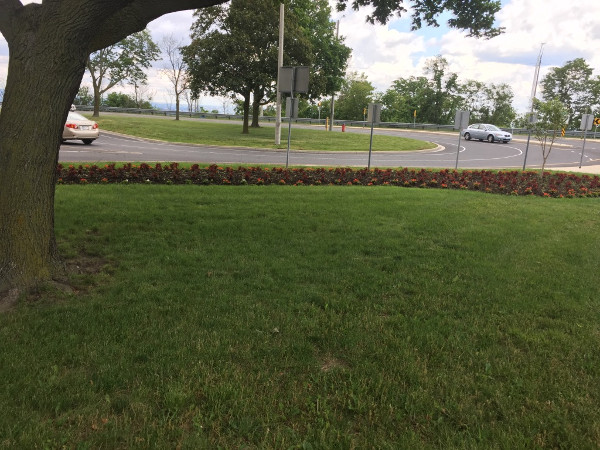
the central point of the quincunx, and I experience no revelation. Nothing. Not even a meditation on Nothing.
No doubt a journey to the Iraq/Saudi Neutral Zone would have been a similar disappointment and been a lot more expensive and would have a lot worse consequences for someone who doesn't obtain permissions.
I consider making the leap to the second teardrop, but I know nothing revelatory is going to happen now. I'll leave it for another day.
Walking back to my car I'm liking 'The Zone' less and leaning heavily to 'No Loitering'. Isn't that what a park is all about? Come. Move around. But don't stay.
Sometimes a whole realm of possibility emerges from tipping one's head back.
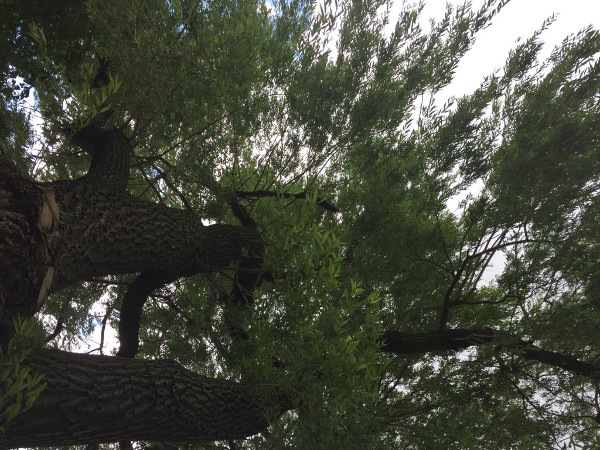
There is a novel by Italo Calvino called Il Barone Rampante (The Baron in the Trees, and yes, that's where the quote at the top of the essay comes from.) Here's what happens.
Cosimo is from "a good family." One evening to escape a dinner of snails, he flees onto the vast family property and disappears up into the trees. He never comes down. Ever. The Baron lives his life up there, traveling wherever he chooses on his own agenda, like the 18th century version of jet trash he is.
He thus lives on a different strata than the rest of us and, sure, it's the Mediterranean not Canada. The temperatures are nice, he's got treeborne mobility across hundreds of kilometres of a natural arboretum, and he can dodge border formalities pretty easily.
He owns the landscape of his narrow altitude, be it wilderness, private property, or that magical region between the two.
Even were an Italian master painter to depict the foliage Cosimo is hiding in, only the most eccentric visitor to the Louvre would imagine that that speck of paint is a human being. But I'll think of Baron Cosimo the next time I look into the hazy distances of the Mona Lisa.
His is a lifetime of loitering.
So what do you call this place? The Zone? No Loitering? Or something entirely else?
By KevinLove (registered) | Posted July 24, 2017 at 09:00:55
Here is the hilarious take of Lloyd "Lindybeige" on signs like "no loitering."
By brendansimons (registered) | Posted July 26, 2017 at 10:46:15
That was a completely unexpected and wonderfully gonzo take. You've captured the surreal weirdness that these spaces have when seen from a pedestrian's point of view. And I love how you describe them as "the very DNA of Hamilton" - you're right, they're a perfect totem for our urban/suburban schizophrenia. Also I learned about art :) Please write more!
You must be logged in to comment.
There are no upcoming events right now.
Why not post one?